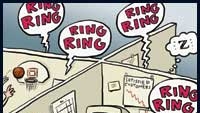Customer No-service

Customer No-service
Your hypothetical attempt at contacting a human regarding your cable problems in your August world edition editorial rang so true. Unfortunately I don't have two potential cable suppliers — Comcast has a monopoly.
I don't subscribe to cable television. I use cable merely for Internet access. Shortly after Comcast took over (bought out) AT&T's cable assets, my cable Internet access bill went from $45/month to $65/month. In addition, the quality of the service went down the drain for nearly two months. Any attempt to find out if the problem was mine or theirs was totally inhibited by an inability to make contact with anyone at Comcast, or even to locate a Web page that would tell me if they were experiencing service problems in my area. I finally resorted to looking up the name and address of the president/CEO and sending my nasty complaint directly to the top. It got a reaction, but I'm uncertain that the problems have been cured.
Michael Ernstoff
Defining vertical resolution
Mr. Robin,
I noticed that you consistently use a completely different definition of “vertical resolution” than just about any other resource. Virtually every textbook, glossary or technical dictionary I've seen states that the vertical resolution of NTSC video is 525 lines. However, you repeatedly adjust this number using the Kell factor, etc and call the adjusted number the vertical resolution. Is there no firm definition of this term within the broadcasting industry? And aren't we usually refering to the maximum resolution when we discuss resolution? Would it be more accurate to describe the adjusted number as the “effective vertical resolution”? Just curious.
Jack G.
Michael Robin responds:
Get the TV Tech Newsletter
The professional video industry's #1 source for news, trends and product and tech information. Sign up below.
Here are a few comments on television vertical resolution:
Fiction: All 525 NTSC scanning lines are visible.
Fact: The NTSC raster is made up of a total number of 525 scanning lines. Between 40 and 45 lines are blanked out, leaving between 480 or 485 active (visible) lines.
Fiction: The NTSC vertical resolution is 525 lines.
Fact: The vertical resolution is neither equal to the total number of scanning lines (525) nor to the active number of lines (let's say 485). This is due to the fact that the scanning lines cannot be assumed to occupy a fixed position with respect to the real-life picture vertical details at all times. So the “statistical” vertical resolution is equal to about 70 percent of the number of active lines or about 339 lines per picture height (LPH).
All television systems have been developed based on these facts. The confusion arises from the fact that computer's vertical resolution is equal to the number of active lines. Computers, unlike television, can assign individual, unambiguous brightness values to each active line. So, unaware of television world realities, people who are migrating from the computer world to television apply computer concepts. I would therefore suggest that the resources you are referring to use a completely different definition of “vertical resolution” than that used by the television world.
The use of computers in the television world can create situations when computer-generated (synthetic) images are mixed and/or alternated with images originated by video cameras. In such cases, the computer-generated images would indeed have a higher vertical resolution than the camera-originated images. This situation would however emphasize an unpleasant television-related artifact called “interlace flicker,” which occurs when the camera-captured vertical detail exceeds 70 percent of the active lines.
June Freezeframe:
Q. One of the 2003 Pick Hit recipients was a second-time winner. The company received its first award in 1990 for its innovation in audio storage. Its 2003 Pick Hit was for a video storage product. Name the company and the technology used as the storage medium in that 1990 Pick Hit award winner.
A. 360 Systems' 1990 Pick Hit winner, the DigiCart, used “Bernoulli” disk technology to record audio.
Winners:
Garen Braun
Brad Meyer, Ozarks Public Television
Alex Joyce, ESPNews
Ken Spickler, Technicolor Creative Services DVD
Steve Alhart, NEP
Bill Gellhaus, WMRG Studios
Test your knowledge!
See the Freezeframe question of the month on page 8 and enter to win a Broadcast Engineering T-shirt. Send answers to bdick@primediabusiness.com
